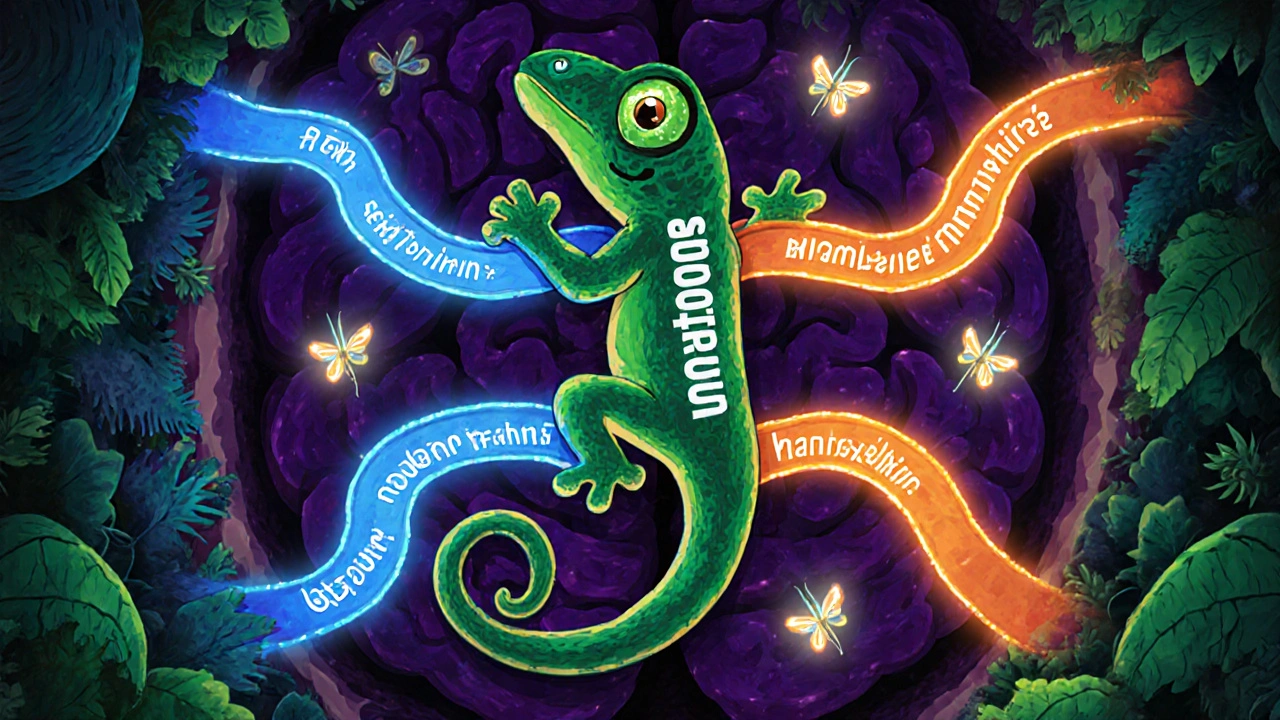Antidepressant Comparison Tool
How This Tool Works
Answer a few simple questions about your symptoms and concerns to see which antidepressants might be most suitable for your situation. This tool uses the comparison framework from the article to help you have informed conversations with your doctor.
Your Symptoms
Key Concerns
Previous Treatment Experience
Recommended Medications
How to Use These Recommendations
These recommendations are based on your responses to the questions above. However, only a healthcare professional can determine the best treatment for you. Bring these suggestions to your next appointment to discuss with your doctor.
When your doctor mentions Asendin as a treatment for major depressive disorder, you probably wonder how it stacks up against the other pills on the market. This guide walks through the science, the side‑effects profile, and the practical pros and cons of Amoxapine compared with the most common alternatives you’ll hear about in 2025.
What is Amoxapine (Asendin)?
Amoxapine is a tetracyclic antidepressant first approved by the FDA in 1979. It’s sold under the brand name Asendin in the United States and several other markets. Unlike newer selective serotonin reuptake inhibitors (SSRIs), amoxapine works by blocking the reuptake of both serotonin and norepinephrine, giving it a broader neurotransmitter impact.
How Amoxapine Works
The drug sits at the intersection of two major mood‑regulating pathways. By inhibiting the serotonin transporter (SERT) and the norepinephrine transporter (NET), it raises levels of both chemicals in the synaptic cleft. Additionally, amoxapine has moderate antagonistic activity at certain dopamine receptors, which can help with low‑energy symptoms that some patients experience.
When Is Amoxapine Prescribed?
- Patients with major depressive disorder (MDD) who haven’t responded to an SSRI or SNRI.
- Individuals who also exhibit anxiety or psychotic features, as amoxapine’s dopamine blockade can have a modest antipsychotic effect.
- Adults 18 years and older; not typically first‑line for teenagers due to limited pediatric data.
Typical starting dose is 50 mg once daily, gradually titrated up to 300 mg depending on response and tolerability.

Key Considerations Before Starting Amoxapine
Every antidepressant comes with a checklist of red flags. For amoxapine, watch for:
- Sedation and drowsiness, especially at higher doses.
- Orthostatic hypotension - rise slowly from sitting.
- Potential for weight gain.
- Rare but serious: seizures, especially in patients with a history of epilepsy.
Because it can affect the QT interval, baseline ECG monitoring is advised for patients with cardiac risk factors.
Comparing Common Alternatives
Below is a side‑by‑side look at the most frequently prescribed antidepressants that doctors consider when amoxapine isn’t the right fit.
| Drug | Class | Typical Dose Range | Primary Mechanism | Common Side Effects | Onset of Action |
|---|---|---|---|---|---|
| Amoxapine | Tetracyclic | 50-300 mg daily | Serotonin & norepinephrine reuptake inhibition, dopamine antagonism | Drowsiness, weight gain, orthostatic hypotension | 2-4 weeks |
| Mirtazapine | NaSSA (noradrenergic & specific serotonergic antidepressant) | 15-45 mg nightly | Alpha‑2 antagonism → increased norepinephrine & serotonin | Weight gain, sedation, increased appetite | 1-2 weeks |
| Sertraline | SSRI | 50-200 mg daily | Selective serotonin reuptake inhibition | GI upset, insomnia, sexual dysfunction | 3-6 weeks |
| Bupropion | NDRI (norepinephrine‑dopamine reuptake inhibitor) | 150-450 mg daily (split doses) | Blocks reuptake of norepinephrine and dopamine | Insomnia, dry mouth, tremor | 2-4 weeks |
| Venlafaxine | SNRI | 75-375 mg daily | Norepinephrine & serotonin reuptake inhibition | Hypertension, nausea, sexual dysfunction | 2-4 weeks |
| Trazodone | SARI (serotonin antagonist and reuptake inhibitor) | 150-400 mg daily | Serotonin reuptake inhibition + 5‑HT2 antagonism | Somnolence, priapism (rare), dizziness | 1-2 weeks |
Deep Dive into Each Alternative
Mirtazapine
Mirtazapine is popular for patients who need a quick lift in sleep quality because it’s taken at night and often induces drowsiness. Its antihistamine effect is a double‑edged sword: great for insomnia, but it can cause pronounced weight gain. For people who struggle with appetite loss, it’s a solid choice.
Sertraline
Sertraline remains the go‑to SSRI for many clinicians because of its relatively benign drug‑interaction profile. It’s effective for both depression and anxiety, but sexual side effects are a frequent complaint. Starting low (50 mg) and titrating slowly helps mitigate GI upset.
Bupropion
Bupropion shines when patients are worried about weight gain or sexual dysfunction. Its dopaminergic boost can also aid smoking cessation. However, it raises the seizure threshold, so it’s contraindicated in those with uncontrolled epilepsy.
Venlafaxine
Venlafaxine offers a middle ground between SSRIs and older tricyclics. It’s often effective for patients with prominent physical pain symptoms because norepinephrine modulation helps with pain perception. Blood pressure monitoring is essential at doses above 225 mg.
Trazodone
Trazodone is widely used off‑label as a sleep aid, but at higher doses it works as an antidepressant. Its side‑effect profile is mild, but the rare risk of priapism makes it a drug to discuss openly with male patients.

Decision‑Making Framework
Choosing between amoxapine and its rivals isn’t just a matter of “which one is newer.” Use this quick checklist:
- Symptom profile: Do you need strong sedation? Mirtazapine or trazodone might win.
- Side‑effect tolerance: Concerned about weight gain? Bupropion or sertraline are lighter.
- Co‑morbid conditions: If you have hypertension, avoid high‑dose venlafaxine; if you have a seizure disorder, skip bupropion.
- Drug‑interaction risk: Amoxapine and venlafaxine can interact with certain MAO inhibitors; sertraline has the cleanest profile.
- Start‑up speed: Mirtazapine and trazodone often show improvement within a week, whereas sertraline may need six weeks.
Bring this list to your next appointment and ask your provider to walk through each point.
Practical Tips for Switching Medications
If you and your psychiatrist decide to move away from amoxapine, follow these steps to keep the transition smooth:
- Set a taper schedule - usually a 25% dose reduction every 1-2 weeks.
- Start the new drug at a low dose before the amoxapine taper finishes to avoid a symptom gap.
- Track side effects daily in a journal; this data helps the doctor fine‑tune the plan.
- Maintain a consistent sleep‑wake routine - many antidepressants affect circadian rhythms.
- Never stop a medication abruptly without medical guidance; withdrawal can mimic a relapse.
Bottom Line
Amoxapine offers a unique blend of serotonin, norepinephrine, and dopamine effects, making it a solid option for patients who haven’t responded to first‑line SSRIs. However, its sedation and cardiac monitoring needs push many clinicians toward alternatives like sertraline for a cleaner side‑effect profile, or mirtazapine when sleep is a major issue. By matching your personal symptom pattern to the strengths and drawbacks listed above, you can have an informed conversation with your provider and land on the medication that fits you best.
How long does it take for amoxapine to start working?
Most patients notice a mood lift within 2-4 weeks, though full therapeutic effect may take up to 8 weeks.
Can I take amoxapine with an SSRI?
Combining two antidepressants can increase serotonin syndrome risk. Always get a doctor’s approval before mixing amoxapine with an SSRI.
Is weight gain common with amoxapine?
Weight gain occurs in about 10‑15% of users, generally linked to increased appetite and sedation.
What makes mirtazapine a good alternative for insomnia?
Mirtazapine’s strong antihistamine effect causes drowsiness, helping many patients fall asleep faster when taken at night.
Are there any foods I should avoid while on amoxapine?
There are no strict dietary bans, but limit caffeine and alcohol as they can worsen sedation and dizziness.
Can amoxapine be used for anxiety disorders?
Yes, especially when anxiety co‑exists with depression, but SSRIs are usually tried first due to a cleaner side‑effect profile.

Sameer Khan
October 22, 2025 AT 20:12In clinical practice, the pharmacodynamic profile of amoxapine warrants consideration of its dual serotonin–norepinephrine reuptake inhibition, complemented by dopaminergic antagonism, which may confer advantages in treatment‑resistant major depressive disorder.
However, the drug’s affinity for α1‑adrenergic receptors predisposes patients to orthostatic hypotension, necessitating vigilant hemodynamic monitoring during dose escalation.
Moreover, the QT‑prolonging potential underscores the importance of baseline electrocardiographic assessment in individuals with pre‑existing cardiac comorbidities.
Emily Collins
October 23, 2025 AT 18:26Wow, the side‑effects list reads like a thriller novel-sedation, seizures, and even cardiac drama!
Harini Prakash
October 24, 2025 AT 16:39Thanks for the detailed rundown! 😊 It’s helpful to know the monitoring steps, especially the ECG part, because many of us feel overwhelmed by the medical jargon.
Vin Alls
October 25, 2025 AT 14:52Dude, if you’re hunting for a night‑time mood boost, mirtazapine is basically the chill pill of the bunch-think cozy blanket vibes with a side of appetite fireworks.
Tiffany Davis
October 26, 2025 AT 12:06I’ve found sertraline’s sexual side effects can be a real downer, so weighing that against its generally mild GI profile is key for many patients.
Bret Toadabush
October 27, 2025 AT 10:19man u cant trust these pharmas, they push amoxapine like it's the cure all while hiding the seizure risk-big pharma is messing with our heads!
Tammy Sinz
October 28, 2025 AT 08:32From a neuropharmacological standpoint, bupropion’s norepinephrine‑dopamine reuptake inhibition offers a distinct mechanistic pathway that circumvents the serotonergic burden associated with SSRIs, making it a viable option for patients concerned about sexual dysfunction.
Christa Wilson
October 29, 2025 AT 06:46Great summary! 👍
John Connolly
October 30, 2025 AT 04:59Folks, remember to taper amoxapine gradually-dropping 25% every week or two can spare you a nasty withdrawal crash and keep the mood swing monster at bay.
Emma Parker
October 31, 2025 AT 03:12yeah, and don’t forget to keep a daily mood journal, it really helps the doc see what’s workin and what’s not.
Joe Waldron
November 1, 2025 AT 01:26The onset of therapeutic effect for most antidepressants, including amoxapine, typically ranges from two to four weeks; however, individual variability can extend this window-monitoring should therefore be individualized and continuous.
Wade Grindle
November 1, 2025 AT 23:39It is also worth noting that the antihistaminic properties of mirtazapine contribute to its sedative effect, which can be advantageous for patients with comorbid insomnia but may be undesirable for those requiring daytime alertness.
WILLIS jotrin
November 2, 2025 AT 21:52When we examine the therapeutic landscape of depression in 2025, amoxapine occupies a unique niche that is often overlooked in mainstream discussions. Its tetracyclic structure endows it with a pharmacological fingerprint distinct from the more ubiquitous SSRIs and SNRIs, combining serotonergic and noradrenergic reuptake inhibition with modest dopamine antagonism. This multimodal action can translate into clinical benefits for patients whose symptom clusters include low energy, anhedonia, and psychomotor retardation, areas where pure serotonergic agents sometimes fall short. Nonetheless, the same receptor profile also invites a constellation of side effects that demand careful patient selection-orthostatic hypotension, sedation, and QT interval prolongation are not merely theoretical concerns but documented clinical realities. The requirement for baseline and periodic ECG monitoring can pose logistical challenges, especially in primary care settings where access to cardiology consultation may be limited. From a pharmacokinetic perspective, amoxapine’s active metabolite, 7‑hydroxyamoxapine, adds another layer of complexity, contributing both therapeutic potency and potential for drug‑drug interactions via CYP2D6 pathways. For patients on polypharmacy regimens, this raises the specter of altered plasma concentrations for co‑prescribed agents such as beta‑blockers or certain antipsychotics. Moreover, the risk of dose‑dependent sedation can be a double‑edged sword; while beneficial for nighttime dosing, it may impair daytime functioning if the dosing schedule is not optimally aligned with the patient’s circadian rhythm. Weight gain, reported in roughly a tenth of users, can be particularly problematic for individuals already battling metabolic syndrome, and may necessitate concurrent dietary counseling. In contrast, alternative agents like bupropion or venlafaxine sidestep some of these metabolic concerns, though they introduce their own profiles of hypertension or seizure risk, respectively. The decision matrix, therefore, must weigh not only efficacy but also tolerability, comorbid conditions, and patient lifestyle preferences. Shared decision‑making becomes paramount, with the clinician presenting a clear comparison of onset of action, side‑effect burdens, and monitoring requirements. Real‑world evidence suggests that patients who are actively involved in selecting their antidepressant report higher adherence rates and better overall outcomes. Ultimately, amoxapine remains a valuable tool in the psychiatrist’s armamentarium, particularly for those with treatment‑resistant depression who have not fared well on first‑line serotonergic agents. However, its use should be reserved for carefully screened individuals, with an eye toward individualized dosing, vigilant monitoring, and a robust support system to navigate its nuanced risk–benefit profile.
Kiara Gerardino
November 3, 2025 AT 20:06While your exhaustive treatise is commendable, it borders on intellectual grandstanding; the average patient simply wants relief without being subjected to a lecture on pharmacodynamics and ECG logistics.
Joanne Ponnappa
November 4, 2025 AT 18:19I see your point – sometimes less is more. 😊